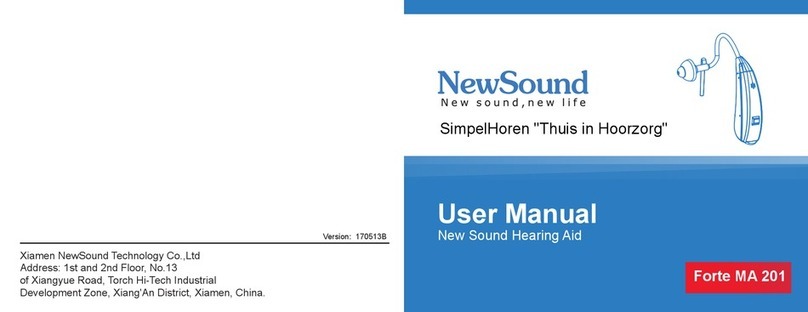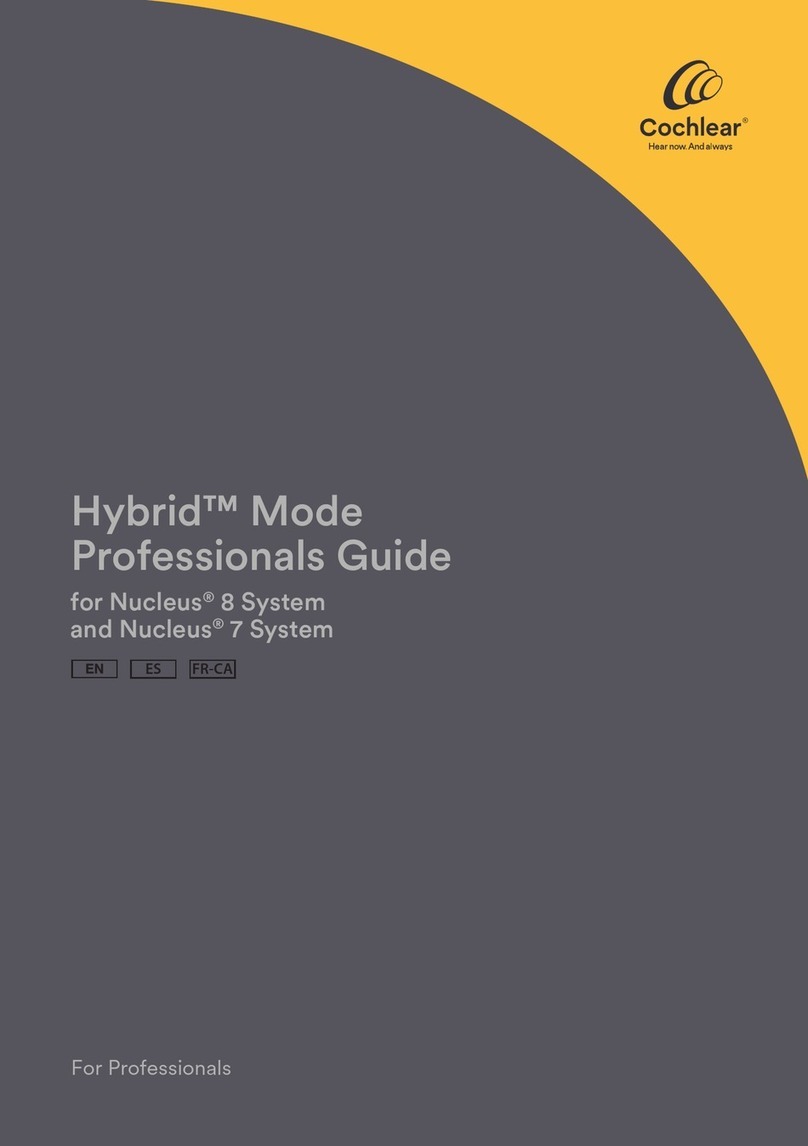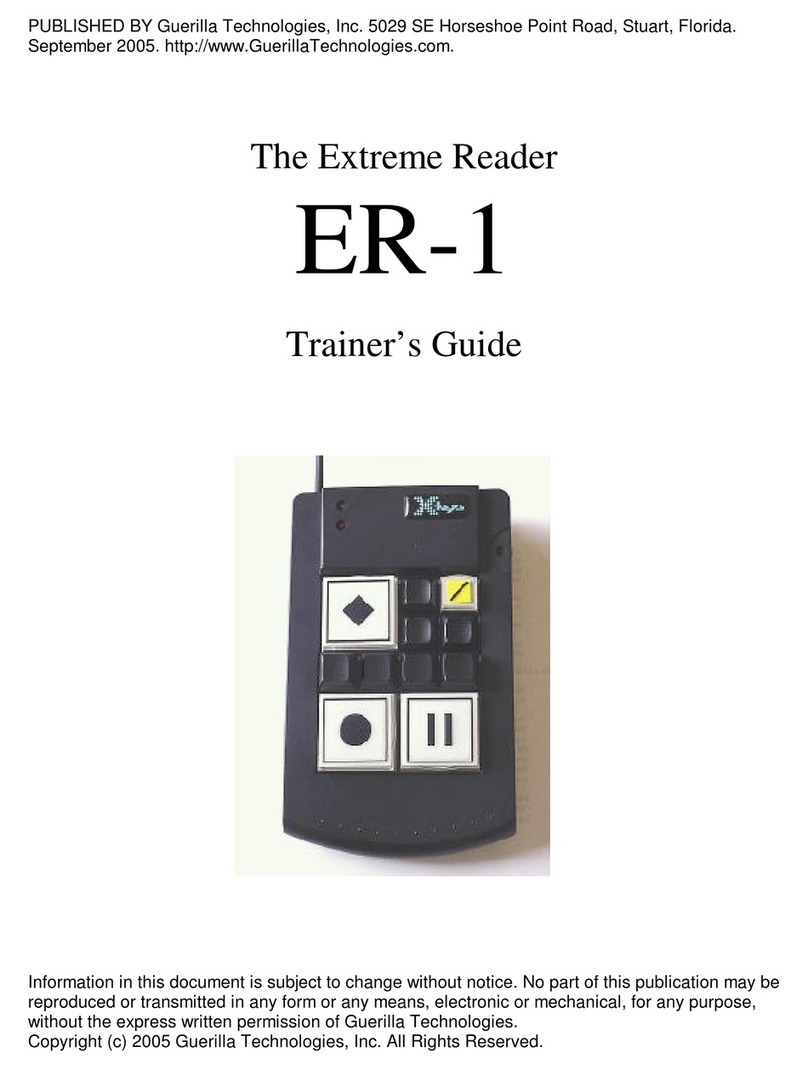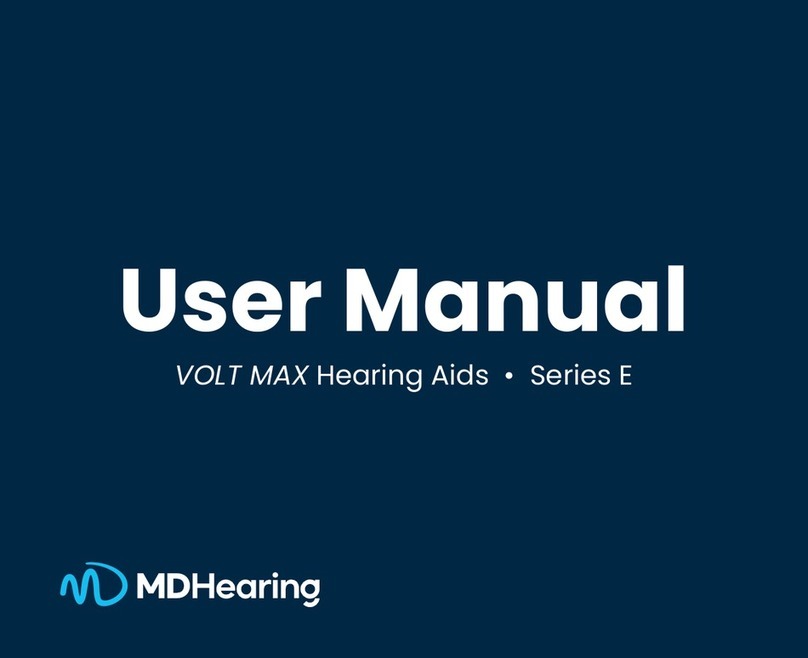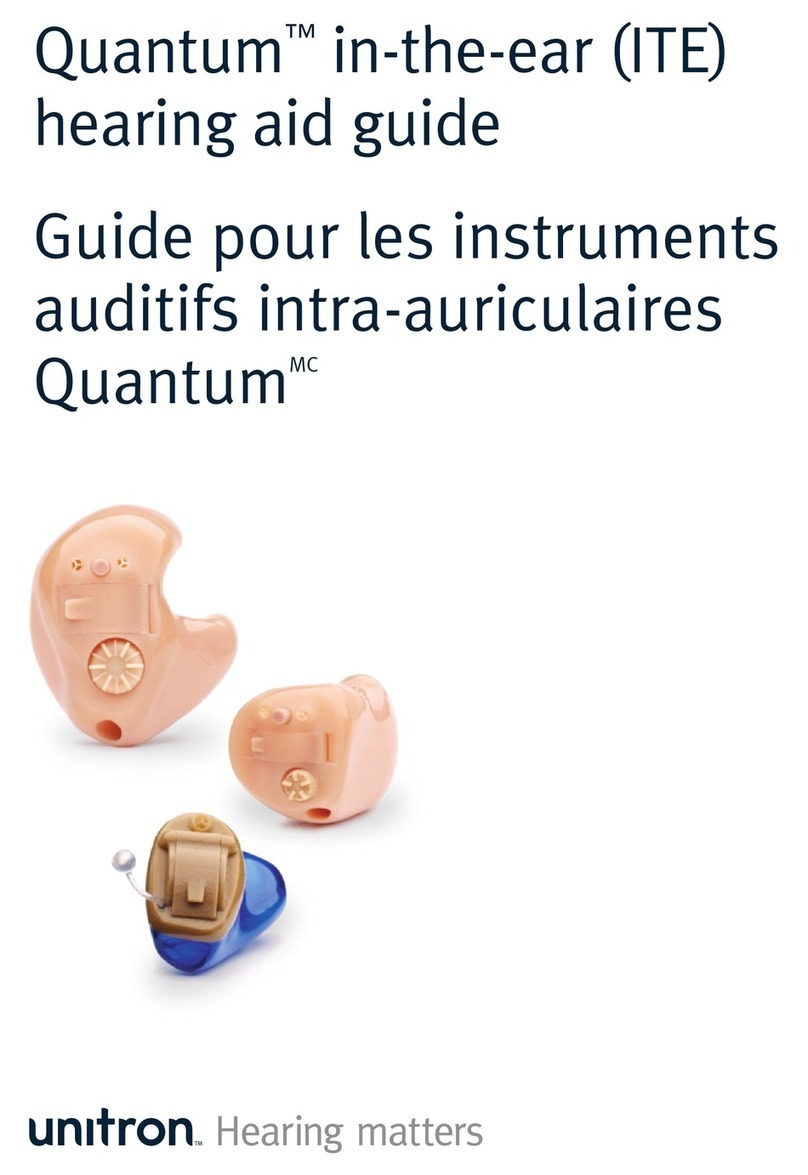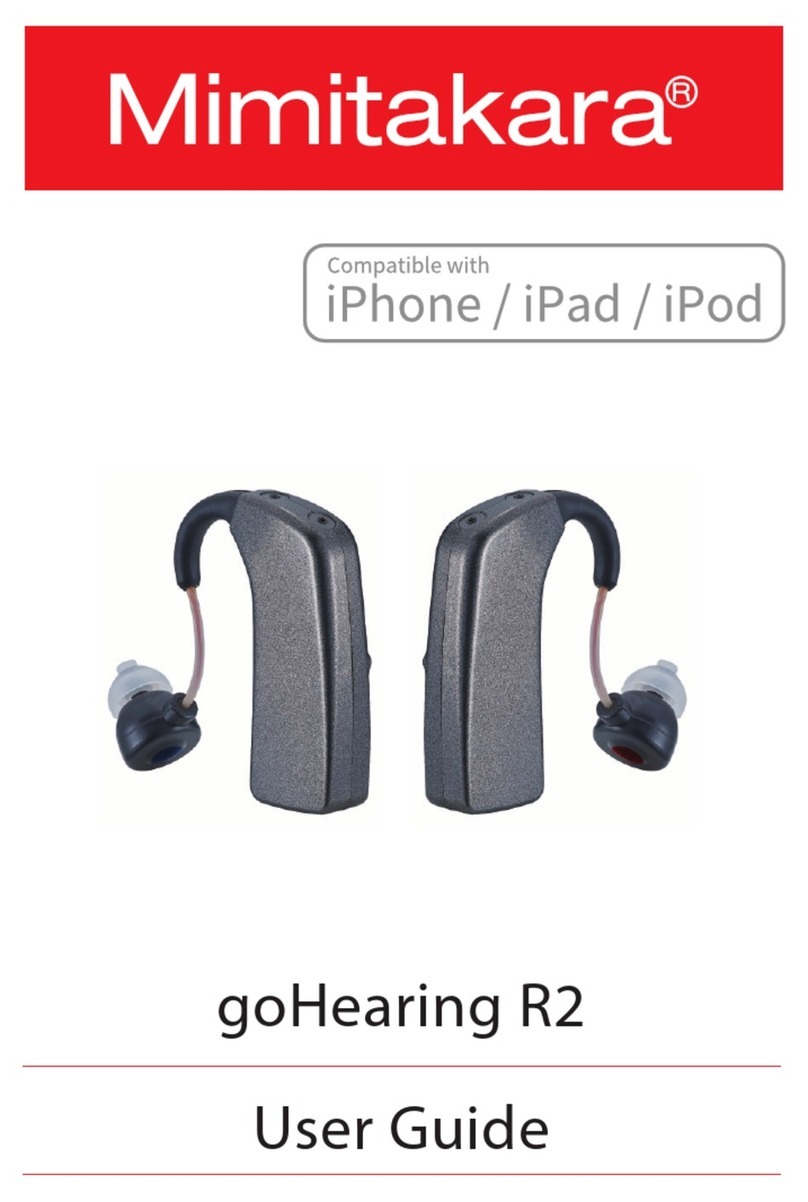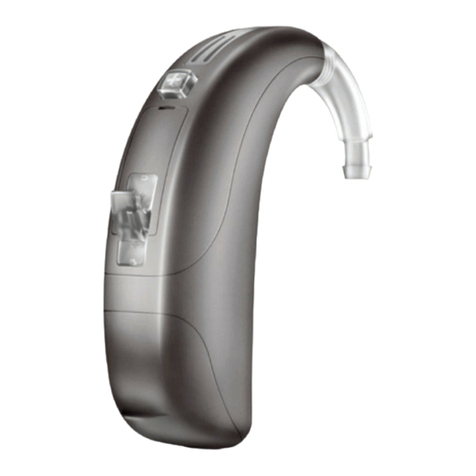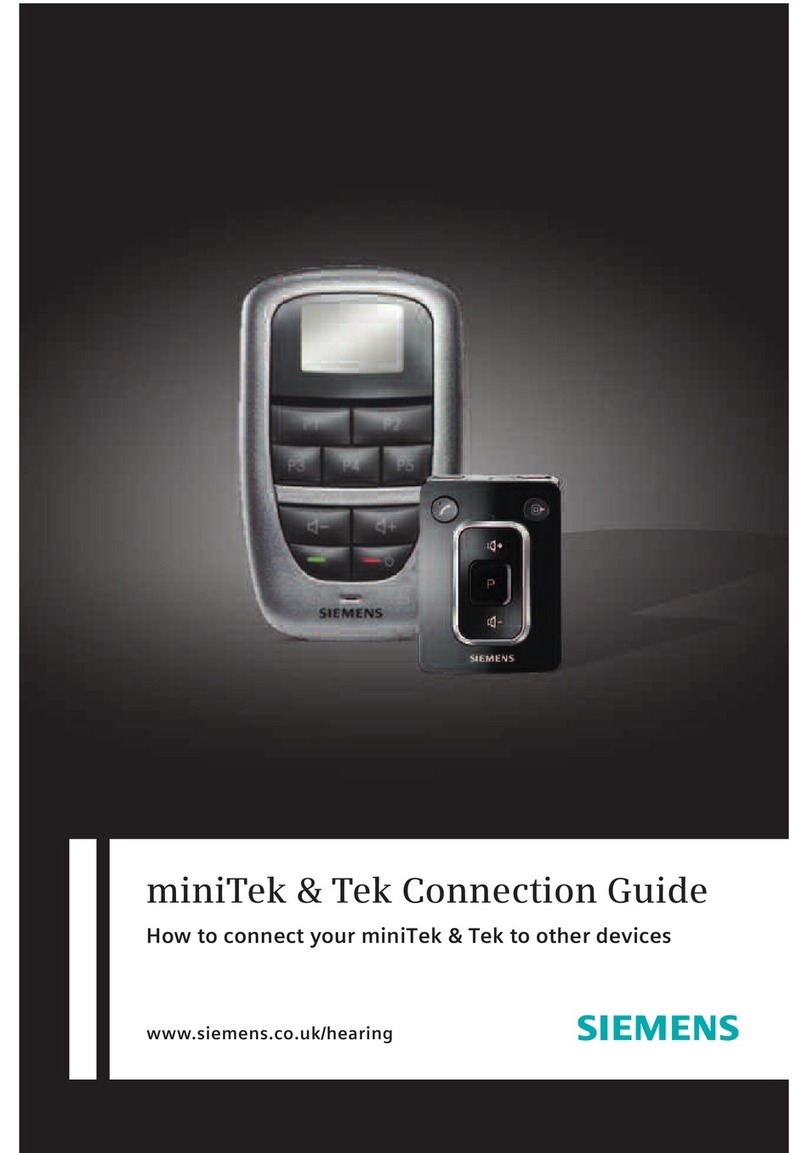NewSound Poco Q User manual

Xiamen NewSound Technology Co.,Ltd
Address: 1st and 2nd Floor, No.13
of Xiangyue Road, Torch Hi-Tech Industrial
Development Zone, Xiang'An District, Xiamen, China.
User Manual
NewSound Hearing Aid
Poco Q

Preface
................................................................................................
..
1
Features.
...............................................................................................4
Preparation............................................................................................5
Operation
...........................................................................................
...
7
Complete hearing instrument assembly .............................................7
How to wear your POCO Q ................................................................8
How to remove your POCO Q ............................................................9
Programming options .........................................................................9
Maintenance
......................................................................................
...
12
Troubleshooting ..................................................................................12
Battery replacement ........................................................................
...
.14
Battery care.........................................................................................15
Whistling noise helpful tips .................................................................16
Cleaning care and precautions ...........................................................17
Appendix
............................................................................................
...
18
Working condition................................................................................18
FDA information...................................................................................19
Service and warranty ..........................................................................23
Contents

1
THANK YOU and WELCOME to NewSound’s most innovative and reliable product,
designed to enhance the quality of sounds in your everyday life!
This user manual only applies to the POCO Q.
In-the-ear (ITE) hearing instrument.
Intended use
This ITE hearing instrument is an electronic device which amplifies sounds
from the surrounding environment. It will help people with mild to moderate
hearing loss or those who just want to enhance their ability to hear
conversations in a noisy environment. Some models are programmed with
tinnitus masking function which used to suppress or mask the ringing effect for
a tinnitus sufferer.
Precautions
For users with ear infection, it is suggested not to wear hearing instrument until
ear normal condition restored or by following a doctor’s advice. Please consult
with your hearing healthcare professional first if you have any questions about
your hearing or your hearing instrument.
THE MANUFACTURER RESERVES THE RIGHT TO MODIFY THE TECHNICAL
SPECIFICATIONS OF THE PRODUCT WITHOUT ANY PRIOR NOTICE.
2
Hazard Warnings – relevant warning notices
Never wear other people’s hearing aid! It could permanently damage/affect
your hearing.
Avoid direct contact with force (e.g. smacking/slapping, wrestling or likewise
sports) while wearing a hearing instrument, such impact could be harmful to
your hearing.
Do not wear hearing instrument in heavy industrial areas (mines, explosion
sites).
If pain, skin irritation in the ear or excessive accelerated earwax, consult
physician.
Hearing aid batteries are toxic. Keep out of reach of children and pets. If
accidentally swallowed, consult physician immediately!
In the unlikely case of the dome being stuck in your ear canal, after the
removal of the sound tube from the ear, it is highly recommended, for you to
see a physician for safe removal of the dome.
– Please read before using your hearing instrument the first time.
Hazard warnings and product safety
Preface

43
Microphone port
Memory switch
Receiver
Battery door 2
4
3
1
Notice: Some models are programmable with a programming port.
The programming port is for hearing professional use only.
Product Safety – relevant product handling and care
Do not drop hearing device onto a hard surface that can damage the
instrument.
When hearing instrument is not in use, leave battery door open so moisture
can evaporate. Store instrument in a safe, dry and clean place.
Remove battery from your hearing instrument if not use for an extended
period of time to prevent dead battery from leakage/expansion that can be
harmful to the instrument.
To obtain best performance from your hearing instrument, always use new
and high-quality batteries.
i
i
i
i
i
Proper disposal of electronic products protects the health of people and the
environment. This symbol means the hearing instrument may not be thrown
away as normal daily waste. Hearing instrument should be disposed at
intended electronic waste/recycle sites, or at your hearing care professional
office.
Features

POCO Q device (1) Cleaning brush (1) User manual (1)
5 6
Kit packaging included:
Memory foam set (size: S, M, L)
Closed domes (size: 9mm, 15mm)
Magic dome (size: 12mm)
Mushroom dome set (size: S, M, L)
POCO Q uses a 10A battery.
IMPORTANT: Insert battery into the battery door compartment with the positive
(+) side (flat side) faced up. If the battery is inserted incorrectly, the
door will not close. Do not force close the battery door!
WARNING: Keep batteries away from children and pets. Seek immediate
medical attention if a battery is accidentally swallowed!
TURN ON - Gently insert battery and close the door. The hearing instrument
has a built-in power on delay, so it will take several seconds for
the device to activate its full functions.
TURN OFF - Simply keep battery door open; also helps extend battery life.
Battery helpful tips
NOTE: Turn OFF instrument if not use in an extended period of time to prevent
damage from battery expansion and leakage.
Preparation

Your hearing instrument consists of two basic parts: The hearing instrument
housing and the dome.
Select the best fit dome size will provide the most comfortable wearing
experience. Memory foam can easily be 'pinched' to make the foam thinner, more
compress, for ease of fitting. The memory foam will return to its original size
after fitting.
7 8
How to wear your POCO Q
Hold the POCO Q between your thumb and index finger, using the hand on the
same side of your hearing instrument.
Insert the instrument canal end first into the ear canal. Gently tug on your ear lobe,
with index finger, push the instrument into the best fit position.
NOTE: It is recommended, before wearing, turn ON the instrument and keep
volume control at lower or at comfortable setting. Volume control at high/loud
setting prior to inserting into the ear can cause feedback from the instrument
and can be uncomfortable to your listening experience.
Complete hearing instrument assembly
Operation

9 10
How to remove your POCO Q
1. Place thumb behind your ear lobe and gently press your ear upward to push
the instrument out of the ear canal.
2. Chewing movements of the jaw will help ease the instrument move out of
the ear canal.
3. Grasp the protruding instrument and remove from ear canal.
WARNING: to prevent instrument damage from misuse, NEVER attempt to
remove your POCO Q by pulling on the volume control or the battery door!
Programming options
Your hearing instrument ‘beeping’ signal will help you identity preset programs.
Example: program 1 will emit 1 beep, program 2 will emit 2 beeps, etc.
Standard/Preset Program: Factory preset programming - available ONLY in
Poco Q 401 with memory switch function.
Programmable: Professional socket programming setting - available in
Poco Q 400/600/800/1600.
Memory Switch: NOT available in Poco Q 400/600/800/1600.
TAP Technology: Available only in Poco Q 800/1600
Your hearing instrument can be programmed up to 4 different listening programs.
When the hearing instrument is turned on, it will automatically be in program 1.
Other preset programs are for your specific needs that can be accessed by
using the memory switch. Pressing of the memory switch will change the
program according to the preset sequence: 1, 2, 3 and 4.

1211
Troubleshooting
SYMPTOM
No sound
or low sound
Whistling,
feedback
POSSIBLE CAUSE
Battery door not closed correctly
Low or dead battery
Sound outlet blocked or damaged
SOLUTIONS
Reopen and close battery door properly
Replace battery
Clear up sound tube or contact hearing
healthcare professional
Volume too low Turn volume higher/louder
Built-in delay power ON feature Wait a few seconds for the device to
turned on
Excessive ear wax built-up Remove/clear wax built-up or contact
your hearing care professional
Hearing instrument not fitted well
in the ear.
Remove and reinsert the instrument
Excessive earwax in your ear Contact your hearing care professional
Volume too loud/high
The instrument was not fitted well
in the ear
Turn down volume
Re-adjust or re-insert the instrument
Program 1
POCO Q400 Normal
Program 2 Program 3 Program 4
POCO Q401
POCO Q600
POCO Q800
Normal Noisy Outdoor
Normal
Normal Noisy Outdoor Telecoil
Standard program setting and recommended using environment:
POCO Q1600 Normal Noisy Outdoor Telecoil
Maintenance
POCO Q201 Normal Noisy Outdoor

When you hear one short beep - signal alerting that battery is running low/out.
Low battery alert will continue intermittently until battery gets replace.
1. Switch off the hearing instrument.
2. Open the battery door and remove the old battery.
3. Remove the protective foil from the new battery.
4. Insert the new battery, and be sure the plus (+) faced up.
5. Close the battery door.
13 14
SYMPTOM POSSIBLE CAUSE
Low or dead battery
SOLUTIONS
Replace battery
Poor battery contact Contact hearing healthcare professional
Sound outlet blocked or
damaged Clean sound outlet or contact hearing
healthcare professional
Sound:
distorted,
unclear,
intermittent,
too much
bass, static
**Too much
Bass May need reprogramming Contact hearing healthcare professional
**Static
Noise
Too close to other
electromagnetic devices/fields
(such as other cell phones,
speakers, etc.)
Move away from other devices/fields
121 13
154
Battery replacement
NOTE: Gentle handing - battery operation needs little effort.
There should be no resistance at closing, for door cannot close if battery
is reversed.

15 16
The sound quality may change after the first warning, this is normal and can be
remedied by replacing with a fresh battery.
To prevent dead battery corrosion inside your hearing instrument ALWAYS
remove the battery if your instrument is not in use for long period of time.
Battery care
The performance of the hearing instrument greatly depends on the quality
of the battery.
1) It is important to use high quality batteries since it helps prevent instrument
from periodic malfunction.
2) Batteries shall be well kept in its original seal and package.
3) Never leave an old or dead battery in the hearing instrument. Leaving a dead
battery inside the instrument for an extended period of time can cause battery
leakage which can be damaging to the instrument.
Whistling is common in small amplifier and is known as 'feedback'.
It is caused by amplified sound leaving the ear and receiving back into
the microphone and being re-amplified. The following tips will help reduce the
effect of feedback/whistle noise:
1. Reduce the volume.
Keep volume at lower setting before inserting the instrument in your ear.
2. Secure instrument fitted position.
Feedback/whistling noise will stop when the instrument is best fitted/sealed
in the ear with the best fitted dome size.
3. Clear the ear canal of wax or debris.
Seek your hearing care provider for excessive wax built-up.
4. Replace the dome.
Select a better fitted size.
Whistling noise helpful tips

17 18
Temperature: –20°/60° Celsius -4°F/140°F
Air humidity: ≤85%
Air pressure: 500~ 1100 KPa
Working condition
DO NOT use water, harsh chemicals, strong cleaners or other fluids to clean the
hearing instrument.
DO NOT leave your hearing instrument in the direct sun or in areas where the
temperature can rise over 60°C / 140°F for extended periods of time.
ALWAYS handle the hearing instrument with care; it’s important to prevent
hearing instrument from dropping on hard surfaces, such as counter
top, table or floor.
Keep the hearing instrument clean and dry. Use only soft cloth to remove any
body oil or moisture from the hearing instrument shell. Use provided cleaning
tools to clean wax built-up. If the instrument is subject to a lot of perspiration, it
is recommended, turned OFF the hearing instrument and put into a dry box at
least once a week. Dry box can be bought online or any local pharmacy.
Cleaning care and precautions
Appendix

19 20
FDA information
Good health practice requires that a person with a hearing loss to have a medical
evaluation by a licensed physician (preferably a physician who specializes in
diseases of the ear) before purchasing a hearing aid. Licensed physicians who
specialize in diseases of the ear are often referred to as otolaryngologists,
otologists or otorhinolaryngologists.
The purpose of medical evaluation is to assure that all medically treatable
conditions that may affect hearing are identified and treated before the hearing
aid is purchased.
Following the medical evaluation, the physician will give you a written statement
that states that your hearing loss has been medically evaluated and that you may
be considered a candidate for a hearing aid. The physician will refer you to a
Hearing Healthcare Professional for a hearing aid evaluation.
The audiologist or hearing aid dispenser will conduct a hearing aid evaluation to
assess your ability to hear with and without a hearing aid. The hearing aid
evaluation will enable the healthcare provider to select and fit a hearing aid
to your individual needs.
Notice to hearing healthcare providers
A hearing aid dispenser should advise a prospective hearing aid user to consult
promptly with a licensed physician (preferably an ear specialist) before dispensing
a hearing aid. If the hearing aid dispenser determines through inquiry, actual
observation, or review of any other available information concerning the
prospective user, that the prospective user has any of the following conditions,
then consult a physician.
If you have reservations about your ability to adapt to amplification, you should
inquire about the availability of a trial/rental or purchase-option program. Many
Hearing Healthcare Professionals now offer programs that permit you to wear a
hearing aid for a period of time for a nominal fee after which you may decide if
you want to purchase the hearing aid.
Federal law restricts the sale of hearing aids to those individuals who have
obtained a medical evaluation from a licensed physician. Federal law permits
a fully informed adult to sign a waiver statement declining the medical evaluation
for religious or personal beliefs that preclude consultation with a physician. The
exercise of such a waiver is not in your best health interest and its use is strongly
discouraged.

21
Stop Using Hearing aids and Consult a Physician if:
* Hearing in one or both ears worsened.
* Your ear becomes occluded with excessive ear wax.
* Hearing does not improve while using the provided hearing aid
* You develop an infection in your ear or ear canal.
* Skin irritation develops in or around your ear canal.
* Visible congenital or traumatic deformity of the ear.
* Unilateral hearing loss of sudden or recent onset within the previous 90 days.
* History of active drainage from the ear within the previous 90 days.
* Audiometric air-bone gap equal to or greater than 15 decibels at 500 hertz (Hz),
1000Hz, and 2000 Hz.
* History of sudden or rapidly progressive hearing loss within the previous 90 days.
* Visible evidence of significant cerumen accumulation or a foreign body in the ear
canal.
* Acute or chronic dizziness.
* Pain or discomfort in the ear.
Children with hearing loss
In addition to seeing a physician for a medical evaluation, a child with a hearing
loss should be directed to an audiologist for evaluation and rehabilitation.
Hearing loss may cause problems in language development, educational
growth, and social growth of a child. Training and experience qualify an
audiologist to assist in the evaluation and rehabilitation of a child with a hearing
loss.
Special care should be exercised in selecting and fitting a hearing aid whose
maximum sound pressure level exceeds 132 decibels because there may be
risk of impairing the remaining hearing of the hearing aid user.
A hearing aid will not restore normal hearing and will not prevent or improve a
hearing impairment resulting from organic conditions. In most cases infrequent
use of a hearing aid does not permit a user to attain full benefit from it. The use
of hearing aid(s) is only part of hearing rehabilitation and may need to be
supplemented by auditory training and instruction in lip reading.
22

23
Service and warranty
Please ask your hearing instrument/care provider, where you purchased your
hearing instrument, about the term of the product warranty and service coverage
with/without warranty.
DO NOT send your instrument directly to the manufacturer for product service or
replacement.
Manufacturer
Xiamen NewSound Technology Co.,Ltd
Address: 1st and 2nd Floor, No.13
of Xiangyue Road, Torch Hi-Tech Industrial
Development Zone, Xiang'An District, Xiamen, China.
European Representative:
Wellkang Tech Consulting Suite B, 29 Harley Street,
LONDON W1G9QR, United Kingdom
www.CE-marking.com
Table of contents
Other NewSound Hearing Aid manuals



